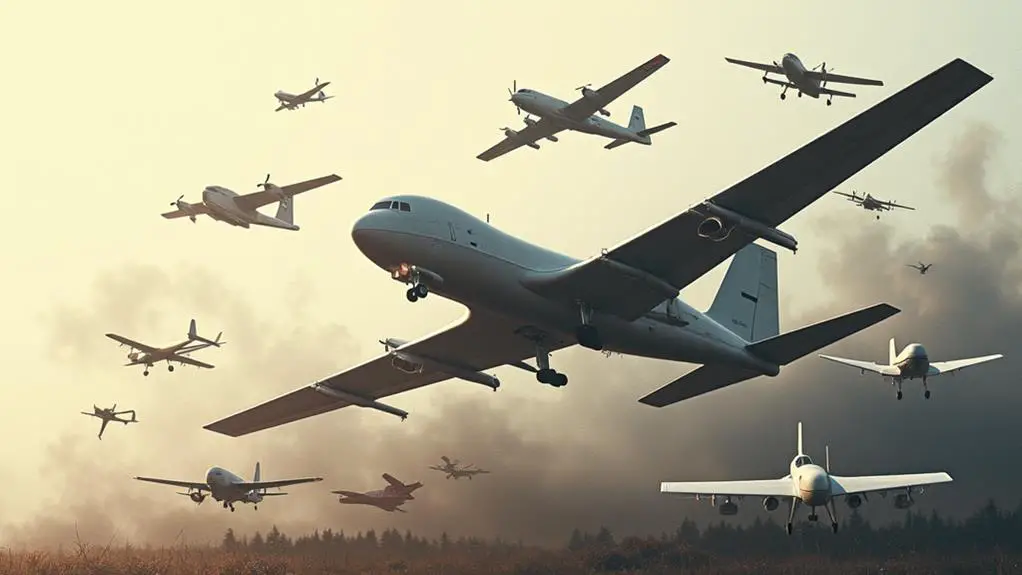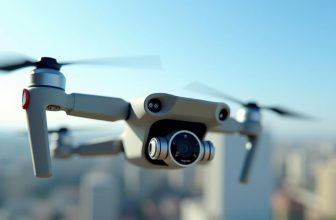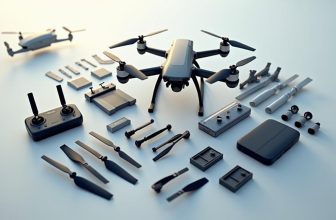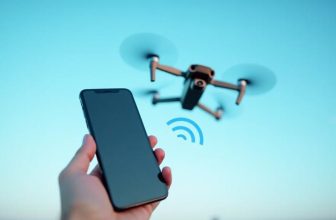
When you think of drones, you likely picture sleek, high-tech devices used for everything from aerial photography to military operations. But have you ever wondered where this technology came from? The history of drones is a story of innovation and adaptation that spans centuries, from ancient Chinese kites to modern unmanned aerial vehicles. By exploring the key milestones in drone development, you’ll gain a deeper understanding of how these devices have evolved over time. As you learn more about the pioneers who paved the way for modern drones, you’ll begin to appreciate the significant impact they’ve had on our world.
Contents
- 1 Key Takeaways
- 2 Early Drone Development History
- 3 World War I Drone Use
- 4 Interwar Period Drone Advancements
- 5 World War II Drone Technology
- 6 Post-War Drone Development Boom
- 7 Rise of Civilian Drone Use
- 8 Modern Drone Regulations
- 9 Advancements in Drone Technology
- 10 Drones in Various Industries
- 11 Future of Drone Evolution
- 12 FAQs: Understanding the History and Evolution of Drones
- 13 Conclusion
Key Takeaways
- Ancient Chinese kites and medieval siege engines laid the groundwork for modern drone technology.
- Nikola Tesla and Samuel Langley pioneered radio-controlled aircraft in the early 20th century.
- World War I and II drove significant advancements in drone development for military operations and reconnaissance.
- Post-war innovations in radio control systems and radar technology fueled the rise of civilian drone use.
- Hobby fliers and aeromodeling competitions played a crucial role in shaping modern drone design and control systems.
Early Drone Development History
Several groundbreaking inventions in the early 20th century marked the beginning of drone development history.
As you explore this period, you’ll find that ancient precursors, such as the Chinese kite and the medieval siege engine, laid the groundwork for modern drone technology.
However, it wasn’t until the early 1900s that innovators began designing and building unmanned aerial vehicles (UAVs).
Drone pioneers like Nikola Tesla and Samuel Langley experimented with radio-controlled aircraft, demonstrating the potential for unmanned flight.
The development of gyroscopes, autopilot systems, and other stabilization technologies further advanced the field.
In the 1910s, the first powered, unmanned aircraft, such as the British “Aerial Target” and the American “Kettering Bug,” were designed and built.
These early drones were primarily used for military target practice, but they paved the way for the sophisticated UAVs of today.
World War I Drone Use
World War I marked a pivotal moment in the development of drone technology, as unmanned aerial vehicles began to play a significant role in military operations.
As you explore the history of drone use during this period, you’ll find that the primary function of these early drones was to gather intelligence on enemy positions.
Aerial reconnaissance became a vital component of military strategy, and drones were used to capture photographs and conduct surveillance behind enemy lines.
You’ll notice that these early drones were often referred to as “flying bombs” or “aerial torpedoes.”
They were typically made of wood or metal and equipped with cameras or explosives.
The Germans, in particular, developed a drone called the “AEG N.I,” which was used for battlefield surveillance.
Although these early drones were relatively simple, they paved the way for more advanced unmanned aerial vehicles in the years to come.
As you analyze the role of drones in World War I, it becomes clear that they played a significant part in shaping the course of military operations and informing future drone development.
Interwar Period Drone Advancements
As you explore the interwar period, you’ll find significant advancements in drone technology, particularly in radio-controlled drone development.
This era saw the introduction of more sophisticated systems, allowing for increased precision and control.
Innovations in target drone design also emerged, with countries like the United States and the United Kingdom developing drones specifically for military training exercises.
Radio-Controlled Drone Development
During the interwar period, radio-controlled drones saw significant advancements, driven in part by the U.S. military’s desire to develop a radio-controlled aircraft for target practice.
As you explore this era, you’ll notice that radio-controlled drone development overlapped with the rise of toy flying and hobby fliers.
Many hobbyists experimented with radio-controlled aircraft, which led to innovative solutions and refinements in control systems.
Hobby fliers, in particular, drove the development of radio-controlled drones by pushing the limits of what was possible.
They experimented with different transmitter and receiver combinations, as well as various control systems, such as pulse proportional and amplitude modulation.
These experiments led to the creation of more sophisticated radio-controlled drones that could perform complex maneuvers.
The convergence of hobby fliers and military interests in radio-controlled drones accelerated advancements in this field.
You’ll notice that many of the innovations that emerged during this period laid the groundwork for the development of modern drones.
As radio-controlled drones became more sophisticated, they paved the way for the widespread adoption of drones in various fields, from military to civilian applications.
Target Drone Innovations
The U.S. military’s interest in radio-controlled drones for target practice drove significant innovations in this era.
As you explore the advancements made during the interwar period, you’ll find that the development of aerial targets was a key focus area. Drones were designed to simulate enemy aircraft, allowing fighter pilots to hone their skills in a more realistic and safe environment.
The U.S. Navy, in particular, played a significant role in driving these innovations, with the creation of the Radioplane OQ-2, a radio-controlled drone used for target practice.
One of the notable innovations during this period was the introduction of drone telemetry.
This technology allowed for real-time monitoring of a drone’s performance, enabling military personnel to track its speed, altitude, and other critical parameters.
As you examine the evolution of drone technology, you’ll notice that this innovation paved the way for more advanced telemetry systems in subsequent drone designs.
The combination of aerial targets and drone telemetry marked an important milestone in the development of drones, laying the groundwork for future advancements in unmanned aerial vehicles.
World War II Drone Technology
As you explore World War II drone technology, you’ll notice significant advancements in radio-controlled planes, which were used for reconnaissance and combat missions.
These early drones also laid the groundwork for target drone development, with countries like the United States and the United Kingdom creating unmanned aircraft for anti-aircraft gunnery practice.
Military drone testing during this period, though limited, played a vital role in shaping the future of drone warfare.
Radio Controlled Planes
Emerging in the 1930s, radio-controlled (RC) planes laid the groundwork for modern drone technology, particularly in the context of World War II.
You might be surprised to know that radio hobbyists played a significant role in this development. As you explore the history of RC planes, you’ll find that they initially catered to the needs of enthusiasts who sought to push the boundaries of aeromodeling.
Aeromodeling competitions, which gained popularity during the 1930s, encouraged hobbyists to design and build more sophisticated models. These competitions and the innovations they sparked fueled the advancements in RC planes.
As you analyze the evolution of RC planes, you’ll notice that they rapidly shifted from simple, single-channel models to more complex, multi-channel systems. This shift was driven by the need for greater control and precision, which ultimately paved the way for the development of more advanced drone technology.
Target Drone Development
During World War II, within the domain of military operations, the focus shifted toward developing advanced radio-controlled planes that could serve as target drones.
You’ll find that the primary objective of these drones was to provide realistic target systems for anti-aircraft gunnery training, allowing gunners to hone their skills in a safe and controlled environment.
The development of these drones was a significant milestone in the history of drone technology.
As you explore the various drone variants developed during this period, you’ll notice that they were often modified versions of existing aircraft, equipped with radio-controlled systems and explosive payloads.
The British, for example, developed the “DH.82B Queen Bee,” a target drone version of the Tiger Moth biplane trainer.
Similarly, the United States developed the “Radioplane OQ-2,” a target drone used for anti-aircraft training.
These early drone variants paved the way for the development of more advanced target systems, which would play a pivotal role in shaping the future of military drone technology.
Military Drone Testing
You’re likely familiar with the concept of drone testing, but the military drone testing that took place during World War II marked a significant turning point in the evolution of drone technology.
This period saw the development of various drone prototypes designed for military purposes. The primary objective of these prototypes was to test their potential as unmanned aerial vehicles (UAVs) for combat and reconnaissance missions.
During World War II, military testing involved several key aspects:
- *Development of radio-controlled drones*: These drones were used for training purposes, allowing pilots to practice their shooting skills without risking human lives.
- *Testing of drone prototypes*: Various drone designs were tested for their aerodynamics, maneuverability, and stability.
- *Assessment of drone payloads*: Researchers explored the use of drones for carrying different types of payloads, such as explosives and cameras.
- *Evaluation of drone control systems*: Military personnel worked on developing control systems that could accurately guide drones during combat and reconnaissance missions.
These military testing efforts laid the groundwork for the development of modern drones, which have become an integral part of modern military operations.
Post-War Drone Development Boom
Following World War II, the development of drones experienced a significant surge, driven by the need for unmanned reconnaissance and surveillance capabilities.
As you analyze this period, you’ll notice that the post-war boom in drone technology was fueled by advancements in radio control systems, radar, and jet engines.
This led to the creation of more sophisticated drones like the Lockheed Q-5, which was the first operational jet-powered drone.
You’ll see that this post-war boom also sparked a drone proliferation trend, with countries like the United States, the Soviet Union, and the United Kingdom investing heavily in drone research and development.
As a result, drones began to play a more significant role in military operations, including surveillance, reconnaissance, and target acquisition.
The 1950s and 1960s saw the development of drones like the Firebee and Lightning Bug, which were used extensively in the Vietnam War.
This period marked a significant turning point in the evolution of drones, setting the stage for their widespread adoption in modern military operations.
Rise of Civilian Drone Use
A pivotal shift in the evolution of drones began to unfold in the late 20th century, as civilian applications started to gain traction, driven by advancements in computer technology, GPS navigation, and the miniaturization of components.
As you consider the rise of civilian drone use, it becomes clear that this period marked a significant turning point in the history of drones.
Civilian adoption of drones was largely driven by the hobbyist community, who were drawn to the technology’s potential for recreational use.
As you examine the growth of civilian drone use, you’ll notice that several key factors contributed to its expansion:
- The development of affordable, user-friendly drone kits that made it easier for hobbyists to build and operate their own drones.
- The emergence of online communities and forums where drone enthusiasts could share knowledge, resources, and ideas.
- The increasing availability of commercial drone products, such as quadcopters and hexacopters, that were designed specifically for civilian use.
- The growing recognition of drones’ potential for applications beyond recreation, such as aerial photography and surveying.
As civilian drone use continued to grow, it paved the way for the development of new technologies and applications that would further transform the industry.
Modern Drone Regulations
As you explore modern drone regulations, you’ll notice that global regulatory frameworks are being established to address concerns surrounding drone use.
You’ll need to ponder how countries like the United States, Canada, and those in the European Union are developing and implementing laws to balance innovation with safety and security.
You’ll also examine how regulators are addressing key issues like privacy and security, as drones increasingly capture and transmit sensitive data.
Global Regulatory Frameworks
Within the domain of modern drone regulations, a patchwork of global frameworks has emerged to address the growing concerns surrounding drone safety, security, and privacy.
As you navigate this complex landscape, you’ll find that different countries have developed their own national policies to govern drone usage.
However, the lack of a unified global standard has created challenges for drone manufacturers, operators, and regulatory bodies.
To address these challenges, international organizations have started to develop global standards for drone regulations.
You can see this effort in the following initiatives:
- The International Civil Aviation Organization (ICAO) has developed global standards for drone safety, which many countries have adopted as a basis for their national policies.
- The European Union’s Aviation Safety Agency (EASA) has established a framework for drone regulations, which serves as a model for other regions.
- The Federal Aviation Administration (FAA) in the United States has implemented a set of rules for drone operations, which has influenced the development of national policies in other countries.
- The Drone Industry Association (DIA) has launched initiatives to promote the adoption of global standards for drone regulations, facilitating international collaboration and coordination.
Privacy and Security
Global regulatory frameworks have laid the groundwork for modern drone regulations, but addressing the complex issues surrounding privacy and security remains a pressing concern.
As you operate a drone, you’re not just flying a device – you’re also collecting and transmitting sensitive data that can be vulnerable to data breaches and cyber attacks.
This is particularly concerning for commercial drones that are used for surveillance, mapping, or monitoring critical infrastructure.
You need to be aware of the potential risks and take steps to mitigate them.
This includes implementing robust encryption methods to protect data transmission, using secure communication protocols, and ensuring that your drone’s software and firmware are up-to-date with the latest security patches.
Additionally, you should be mindful of your drone’s physical security, such as storing it in a secure location and using tamper-evident or tamper-resistant casing.
As the use of drones continues to expand, it’s essential that you prioritize privacy and security to prevent unauthorized access to sensitive information.
Advancements in Drone Technology
Diving into the world of drone technology, you’ll notice that the past decade has witnessed significant breakthroughs.
These advancements haven’t only improved the performance and capabilities of drones but have also paved the way for their widespread adoption.
One of the key areas of development has been drone miniaturization, which has enabled the creation of smaller, more agile drones that can be used in a variety of applications.
- Advancements in materials: New materials and manufacturing techniques have enabled the creation of lighter, stronger drone frames that can withstand the stresses of flight.
- Aerial autonomy: Improvements in autopilot systems and sensor technologies have enabled drones to fly autonomously, traversing through complex environments with ease.
- Increased computing power: Advances in computing power have enabled drones to process large amounts of data in real-time, allowing for more sophisticated flight control and navigation systems.
- Improved sensor technologies: Advances in sensor technologies have enabled drones to detect and respond to their environment in more sophisticated ways, such as through the use of LiDAR and stereo vision systems.
Drones in Various Industries
As you explore the broader applications of drones, it becomes clear that the advancements in drone technology have opened up a wide range of possibilities for various industries.
One industry that has greatly benefited from drone technology is agriculture. Agriculture drones, equipped with high-resolution cameras and sensors, are used to monitor crop health, detect pests and diseases, and optimize irrigation systems.
This information enables farmers to make data-driven decisions, increasing crop yields and reducing costs.
Drones are also being used in environmental monitoring, helping to track climate changes, monitor wildlife populations, and detect natural disasters.
Equipped with specialized sensors and cameras, drones can collect detailed data on environmental conditions, such as air and water quality, and track changes over time.
This information is invaluable for researchers and policymakers, enabling them to make informed decisions about environmental conservation and management.
The use of drones in these industries hasn’t only improved efficiency but also reduced costs and increased accuracy, making them an essential tool for professionals working in these fields.
Future of Drone Evolution
Looking ahead to the next decade, you’ll likely witness significant advancements in drone technology, spearheaded by innovations in autonomous systems, artificial intelligence, and the Internet of Things (IoT).
As the industry continues to evolve, you can expect to see drones become increasingly integrated into various aspects of your life, from delivery services to environmental monitoring.
Some key developments to watch out for include:
- Drone Autonomy: Next-generation drones will be equipped with advanced autonomy, enabling them to navigate complex environments and make decisions in real-time.
- Aerial Internet: The integration of drones with 5G networks will create an aerial internet, providing high-speed connectivity to remote and underserved areas.
- Swarm Intelligence: Swarms of drones will be able to communicate and coordinate with each other, enabling complex tasks such as search and rescue operations.
- Edge Computing: With the increasing amount of data generated by drones, edge computing will become essential for processing and analyzing data in real-time, reducing latency and improving overall efficiency.
FAQs: Understanding the History and Evolution of Drones
Can Drones Be Used for Environmental Conservation Efforts?
You can utilize drones for environmental conservation efforts, as they’re ideal for wildlife monitoring and ecosystem assessment, providing detailed insights into species populations, habitats, and ecosystem health, helping you make informed conservation decisions.
How Are Drones Used in Disaster Response Situations?
You’re the eye of the storm, swiftly traversing disaster zones. Drones play a vital role in Emergency Response, rapidly conducting Damage Assessment to identify affected areas, prioritize aid, and allocate resources efficiently, saving lives.
Can Drones Operate Underwater or in Extreme Weather?
You’re exploring drones in harsh environments, and yes, they can operate underwater and in extreme weather. Specialized drones handle ocean exploration, while weather-resistant models withstand turbulence, enabling you to gather data in various conditions.
Are Drones Used in Space Exploration Missions?
You’re likely familiar with space probes and planetary scouts, but you might not know they’re fundamentally drones used in space exploration missions, designed to gather data and transmit information from distant planets and celestial bodies.
Can Drones Be Used for Medical Supply Delivery?
You can utilize drones for medical supply delivery, enhancing Medical Logistics in remote areas. They’re particularly useful in Emergency Response situations, quickly transporting critical supplies like blood, vaccines, and medications to those in need.
Conclusion
As you reflect on the history and evolution of drones, consider this: the global drone market is projected to reach $41.3 billion by 2026, growing at a CAGR of 13.8%. This statistic underscores the profound impact of drone technology on various industries, from surveillance to recreation. The continuous advancements in drone capabilities and regulations will shape their future applications, transforming the way we live and work. The evolution of drones is a milestone to human innovation and adaptation.






